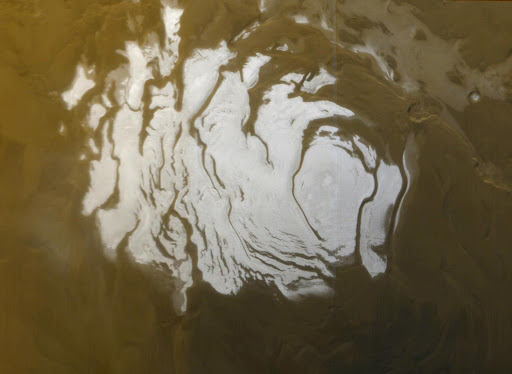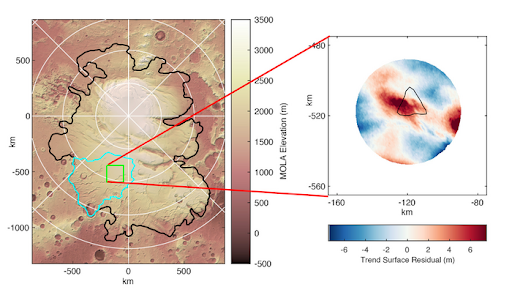By Raquel Santos
An international team of researchers, led by the University of Cambridge, has found new evidence that suggests the existence of liquid water under the South polar ice cap of Mars. Using spacecraft laser-altimeter measurements, researchers provided the first line of evidence, without using radar, that our neighbor red planet might contain water under its icy surface.

(Image Credit: Photo by NASA/JPL/MSSS (Source: Wikipedia))
The findings give way to a wide variety of implications. The main one is that there is a probability that Mars is geothermally active.
A back-and-forward debate
In 2018, the European Space Agency’s Mars Express satellite provided some evidence that indicated that there was liquid water under Mars’ southern ice cap. Using its ice-penetrating radar, MARSIS, revealed an area at the base of the ice that reflected the radar signal.
These measurements were originally interpreted as a possibility of the presence of water beneath the ice. However, researchers were quick to refute it.
Subsequent studies showed that other types of dry material produce similar responses to the ones found under the martian ice cap. And because the climate conditions on Mars are so cold, liquid water beneath the ice would require additional heat sources that weren’t expected to exist on this planet at the time. The radar signal also appeared in some orbital passes but not others.
This debate put the theory on standby, waiting for another line of evidence that could either support it or disprove it completely.
Is that water?
Results from the recent research, published in the Nature Astronomy journal, provide additional evidence that there could, in fact, be liquid water under the southern martian polar ice cap. The team used a wide variety of techniques to examine the surface of Mars’ south polar ice cap where the radar signal was identified.
The analysis showed a 10-15 kilometer-long surface undulation, with depressions followed by raised areas, similar in scale to undulations over subglacial lakes on Earth.

(Image Credit: Original Article)
Then, the researchers tried to determine whether these undulations could be explained by liquid water under the cap. They ran computer simulations of ice flow adapted to the conditions found on Mars.
These models predicted what would happen beneath the ice cap if there was liquid water present. They also inserted various levels of geothermal heat coming from inside the planet. The experiment generated undulations that were similar in shape and size to the ones observed on the real ice cap surface.
Professor Neil Arnold, the leader of the research, said: “The combination of the new topographic evidence, our computer model results, and the radar data make it much more likely that at least one area of subglacial liquid water exists on Mars today, and that Mars must still be geothermally active in order to keep the water beneath the ice cap liquid.”
Where there’s water…
There might be water on Mars, but it doesn’t mean that there’s life. However, it makes it a bit more likely that it could’ve existed in the past when the planet’s conditions were a lot different than what they are today.
For the water to be liquid under the martian ice caps, in such cold conditions, it would need to be extremely salty. That, combined with the harsh conditions of the red planet would make it difficult for even the most extreme microbial life to survive. If martian microbial life is anything like the one existing on Earth, that is.
Still, this discovery could potentially open new paths to help us understand if there were any habitable environments on Mars in the past. It could also be used as a starting point to trying to figure out more about other planets as well.
“The quality of data coming back from Mars, from orbital satellites as well as from the landers, is such that we can use it to answer really difficult questions about conditions on, and even under the planet’s surface, using the same techniques we also use on Earth,” said Arnold. “It’s exciting to use these techniques to find out things about planets other than our own.”
Sources:
https://www.eurekalert.org/news-releases/966152
https://www.science.org/content/article/liquid-water-spied-deep-below-polar-ice-cap-mars
https://www.nature.com/articles/s41550-022-01782-0
https://www.outlookindia.com/international/explained-how-scientists-found-new-evidence-of-liquid-water-below-ice-caps-on-mars-news-227748
